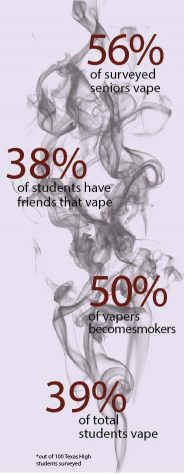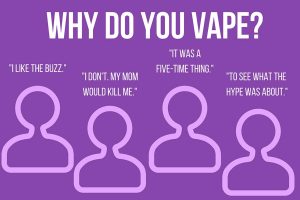Where there’s smoke, there’s fire
Popular rise of e-cigarettes contains potential health effects
May 25, 2018
You huff. And you puff. And you blow a fat cloud. But unlike asthma, there is no medicine for vaping.
Ever since Americans realized the consequences of smoking cigarettes, the tobacco industry has developed various methods to replace nicotine in the cessation, or halting, of smoking. Nicotine patches, nicotine gum and in recent years, vaping, or the usage of e-cigarettes, have allowed former ex-smokers to gradually wean off of their addiction to nicotine.
“The original purpose for e-cigarettes and vapes was to kick the habit of smoking and [decrease use] of traditional cigarettes, which have over 35 carcinogens in them,” pulmonary doctor Christopher Bailey said. “This way, they could use the vapes as a nicotine substitute to principally administer nicotine with an optional flavoring element.”
However, as youth culture continues to be defined and redefined in America, vaping has infiltrated the lives of millions of young people ever since it was considered trendy by popular culture icons. Vaping for non smokers has been shown to act as a gateway to smoking.
“It has become the hip thing to do,” Bailey said. “It is a way to fit in with the rest of [one’s] peers, and lots of teenagers who were not smokers to begin with start to vape. In fact, over 50 percent of young folks who vape will begin to smoke cigarettes within a few years.”
Despite the original intent of e-cigarettes to assist smokers to quit their habit, the nicotine in vapes has proven addictive enough to attract new users.
“There’s a lot of originally developed [solutions] for helping with smoking cessation, and it’s mostly in the young folks,” Bailey said. “They’re abusing vapes because they don’t see it as harmful. The vapes have been more deceptive than any other nicotine product.”
As the user becomes more addicted to nicotine in the vape, they seek out more by vaping through a particular method. Dripping, a process in which users drop vape liquid directly onto the heating coil, allows them to produce a thicker, more flavorful smoke.
“The big problem, though, is that even though it doesn’t have all the carcinogens traditional with the cigarette, there are some of the devices and some of the methods by which people abuse the vape,” Bailey said. “There’s a process called dripping, and it actually concentrates more nicotine per puff when they manipulate the e-cigarette.”
Even though nicotine is highly addictive, it is only one of many chemicals that is addicting and commonly abused or used.
“There’s so many things that we’re exposed to that have that same potential character [of addictiveness], so it’s not the product,” Bailey said. “It is like demonizing coffee. It’s nicotine smeared with a stimulant, and it’s a highly addictive stimulant.”
The addictive and habitual desires caused by nicotine from vapes can also be stimulated through the hand to mouth use of the cigarette to simulate a traditional cigarette. The potential drawbacks from this “hand to mouth” syndrome are weight gain and vaping after smoking.
“Part of the problem with many smokers is that when they do try to quit, individuals can end up gaining tremendous amounts of weight,” Bailey said. “Instead of having the hand to mouth function of the cigarette, they take up the fork instead. Due to the fact that their taste buds function better when they quit smoking, food tastes better.”

Furthermore, vapes cause long-term health effects, such as increasing the risk of cancer and cardiovascular diseases.
“Even though there is a low carcinogenic rate with e-cigarettes, a vape’s height net carcinogenic potential would increase by abusing this drip technique,” Bailey said. “As far as if it’s safer from a cancer perspective, if you use [a vape] the way it was originally designed, it is actually lessened considerably. However, you increase your risk for exposure to those aldehydes and the risk for carcinogenic potential [when dripping].”
Even without dripping, e-cigarettes have long-term health consequences.
“Health hazards increase with the utilization of methods to strengthen the ‘high’ from vapes, such as cancer risk, increased cardiovascular disease, increased risk for smoking, and stroke risk for smokers,” Bailey said. “As a society, we hope to reduce risk for cancer, and vapes appear to be doing the opposite.”
Critics have accused e-cigarettes of being a gateway to drugs, but this is not necessarily the case.
“I do not believe in a ‘gateway drug’ because any use of a drug always has the potential to establish habituation,” Bailey said. “It’s how the person who’s using the drug looks at it. ”
Despite the high risks, little is being done to expose the dangers of vaping.
“It’s a matter of personal choice. There needs to be more education on the risks involved with vaping at a young age and vaping for the wrong reasons,” Bailey said. “But, there’s no campaign right now to really pursue that. If you look at the federal government, they’re not spending any money to educate young people about vaping very much.”















Albert • Jun 20, 2018 at 8:32 am
yeah !There are many true lines in this article about vape health issues but i think there are many other positive aspects also associated with vaping like it can be helpful to quit smoking as smoking is very dangerous for health and as far as vape concerned with teenagers it is banned for all the under 18 years kids.For further information , for the people which wanna switch from cigarette to e-cigarette and want to buy vape things at wholesale rate visit http://www.ecigarettes-wholesale.uk .